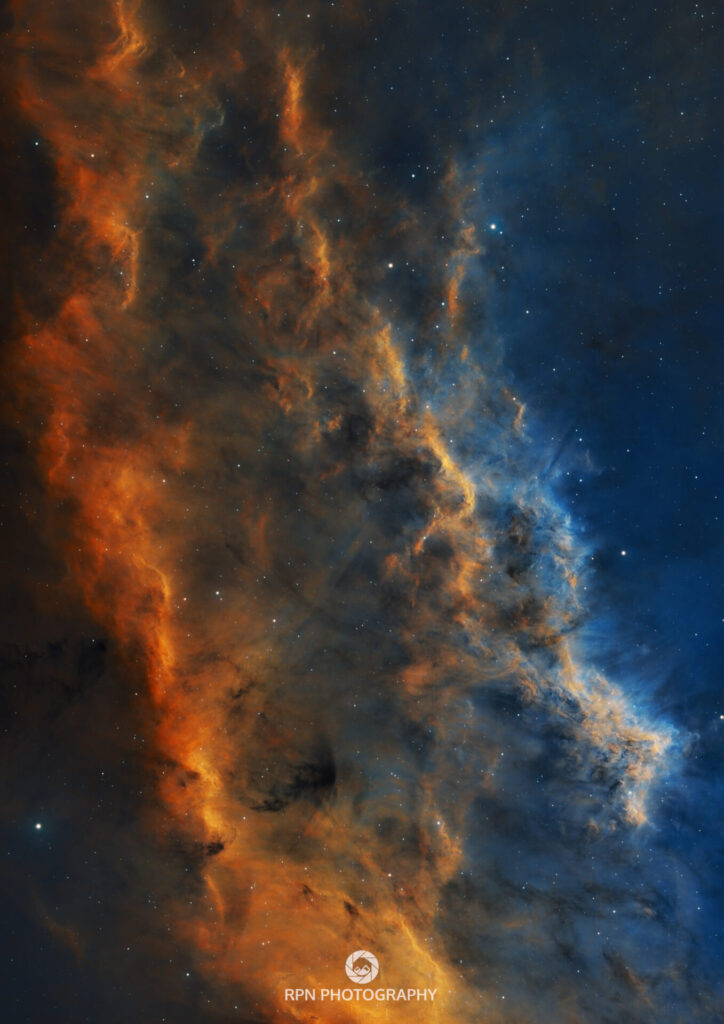Like all astrophotographers, the March skies meant that Rob Nolan had an impossible month – but he did capture a stunning nebula in February
Well, its official, it was the wettest March we’ve seen since 1981. Which means it’s the wettest March I’ve ever seen!
I don’t think myself or any of my fellow Astrophotographers managed to collect any images last month, and we were all extremely grumpy because of it! We live in hope of some cloudless and moonless nights in April to reinvigorate us and to try and capture some data as the days grow longer and the nights grow shorter. The worst thing about the bad weather, is we all tend to get bored and go and buy more equipment to make ourselves feel better! Never a good thing!
My image this month is one I shot back in February, and turned out to be my last nebula shot of winter as we are now giving way to galaxy season again.
The California Nebula
A large emission nebula stretching across almost 2.5 degrees of the night sky, the California Nebula (NGC1499) is in the constellation Perseus. It is so named because its shape is reminiscent of the outline of the US state of California on a map.
The Nebula stretches about 100 light years across. Despite its huge size and visual magnitude of 6.0, the nebula is still very difficult to observe visually because it has a low surface brightness.
However, when photographed using Narrowband filters which pick up hydrogen, sulphur II and oxygen lll emission bands, details come alive on this massive structure. I’m always in awe when zooming in around the high resolution version of this image to see all the different shapes that create this truly stellar nebula.
It was discovered by American astronomer Edward Emerson Barnard – renowned for his catalogue of dark nebulae and his pioneering work in astrophotography – in 1884. This image was captured with my 1000mm Maksutov Newtonian Telescope and the ZWO ASI2600MM Pro Astro camera with Narrowband filters and is about 8 hours of data.
The night sky, April 2023 – Rob’s guide for your stargazing this month:
Now that the spring equinox has come and gone, we start to see the nights get shorter; always a sombre time for astronomers! Thankfully though, there’s still plenty of astronomical darkness in April to keep us entertained, clouds permitting!
Since the clocks went forward, there’s more chance that we’ll be back home from work and settled as night falls, so now is a really good time to take a look at our three nearest neighbours ton view in the evening sky; Mercury, Venus and Mars.
It’s a really good time to try to observe Mercury, which never strays far from our sun and follows a very tight oval-shaped orbit, completing one year in just 88 Earth days.
Imagine having to go through Christmas dinner and all the trimmings every 88 days!
The fight for the title of brightest object in the night sky this month includes stars from several constellations. Regulus in the constellation Leo, Spica in Virgo and the unmistakable orange glow of Arcturus in Boötes.
One of the prominent constellations this month is Virgo, with its Y-shaped appearance, it’s the second largest constellation in the night sky. The glory of Virgo , so named because the pattern traditionally represents a victorious maiden holding an ear corn, lies in the ‘bowl’ of the Y shape. If you scan the upper region with a small telescope at a low magnification, you’ll find this part of the constellation packed with faint, fuzzy blobs. These are just a few of the 2,000 galaxies that make up the gigantic Virgo cluster.
Dates to remember
Events to make a note of this month include observing our local neighbourhood, starting on the 11th as brilliant Venus is positioned left of the Pleiades.
Wake up early on the 16th to catch Saturn above the crescent Moon before dawn.
We’ve got an excellent chance of observing the Lyrid Meteor shower this year on the night of the 22nd to 23rd of April. This is because the Moon isn’t in the way to obscure the display, so it’s definitely one to watch if the clouds oblige!
The Lyrids appear to emanate from Lyra – a small constellation named to represent the lyre of Orpheus in the northern sky –as we pass through debris from Comet Thatcher.
On the 23rd, look towards the crescent moon at twilight and you’ll see Venus, hanging like a pendulum below the clock face of the Moon.
Finally, on the 25th, you’ll be able to observe Mars close to the Moon, next to stars Castor and Pollux.
Until next time, clear skies!


